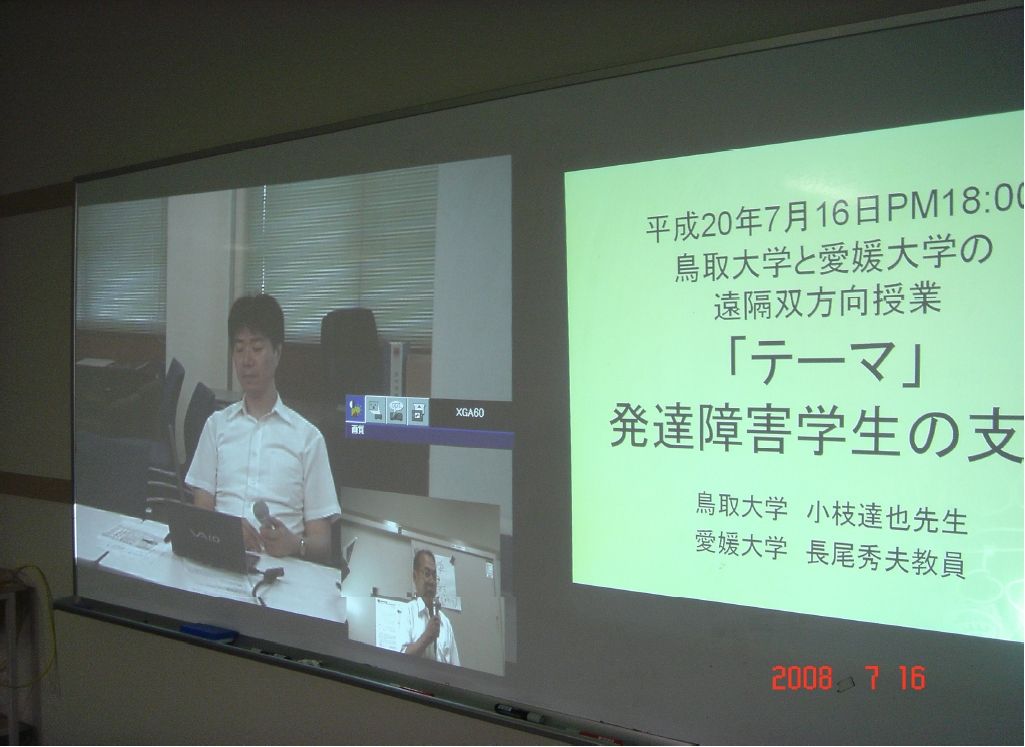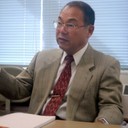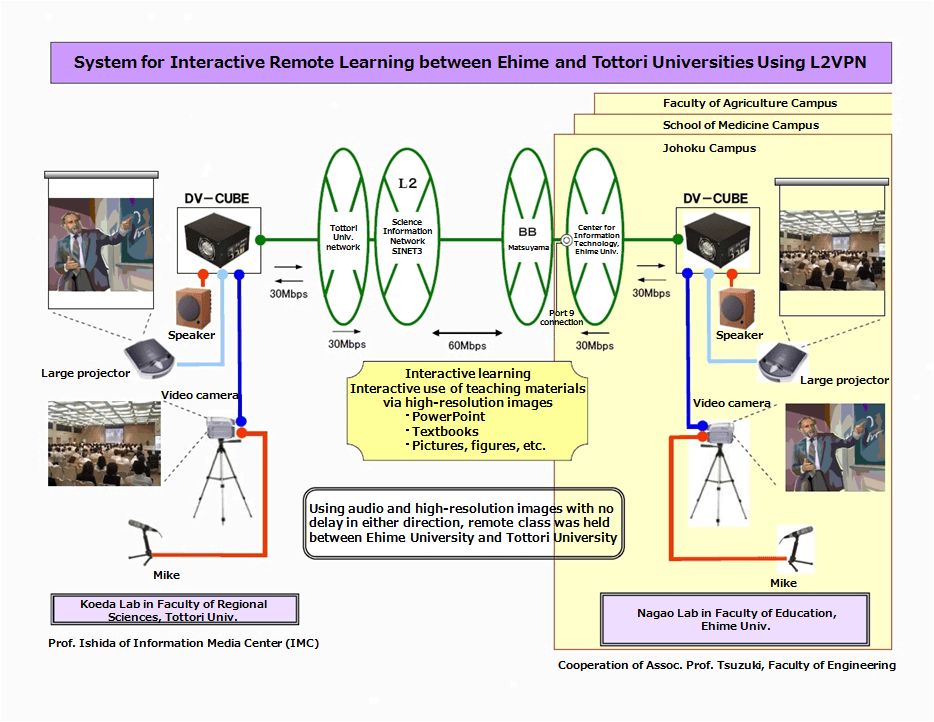
Interactive Remote Learning in Special Support Education
The Nagao Laboratory in the Ehime University Faculty of Education has been studying the possibilities for use of interactive remote learning in special support education. The researchers have been exploring this potential in various projects, including the holding of actual remote learning over links to the Koeda Laboratory in the Department of Regional Education, Faculty of Regional Sciences, Tottori University. We talked with Professor Hideo Nagao of the Faculty of Education, Ehime University, about the aims of these efforts.
(Interview date: October 3, 2008)
Professor Nagao, can you tell us how you became involved in special support education?
Nagao: I am originally a pediatrician specializing in pediatric neurology, that is, research on the brains, muscles, and so on of children. Even today I am continuing in this practice and often receive inquiries from patients and their families. My experiences made me aware of the need for improvements in the educational and living environments of children with disabilities. That’s why around 20 years ago I joined the Faculty of Education, becoming involved in special support education, which at that time was known as “disabled children” education.
Special support education courses are offered in the fields of pedagogy, psychology, and medicine. My responsibility is in medicine. When I first joined the Faculty of Education, nearly all the physicians teaching in education departments throughout Japan were in the field of psychiatry. There were only one or two pediatricians. The number of pediatricians in this area has lately been growing steadily, however. Medical support is essential for children with developmental disabilities, which is why we pediatricians are also making an effort to establish educational methods in this field and to train teachers who are familiar with these methods.
Over the past several years, you have been involved in various other remote learning projects, right?
Nagao: That’s correct. Ehime Prefecture has facilities for special support education in a number of locations, including care centers for children and special support schools. Our university dispatches graduate students majoring as special education support coordinators to primary and middle schools. Since the 2006 academic year we have been using a videoconferencing system to provide them with instruction and educational consultation.
Since the terminal for this system installed at the receiving ends had a small built-in display only, it was not feasible to use this for large-scale interactive learning with dozens of students. Besides, the screen resolution was not very high. In 2008 we introduced a new remote learning system, DV-CUBE (made by FA System Engineering Co., Ltd.) with digital video cameras, enabling use of a projector and having sufficient resolution for reading camera-captured text documents at the remote location.
The entire Faculty of Education is excited about using remote learning. One reason is the program of taking classes for renewing teaching licenses, which started up this year on a trial basis and affects around 3,000 teachers in Ehime. It would not be efficient to teach the same class over and over again, not to mention the load on teachers from needing to travel to the site of the classes. It should be possible to alleviate these problems to a certain extent by dividing the prefecture into a number of areas and offering the classes by remote learning.
What was the occasion for setting up interactive remote learning with the Koeda laboratory in Tottori University?
Nagao: It is very meaningful for students to hear the views of various instructors, which I assume is true in other disciplines as well. Professor Tetsuya Koeda, of the Department of Regional Education, Faculty of Regional Sciences, Tottori University, happens to have the same field of specialty as mine, pediatric neurology, and we have come to know each other also through working together in a study group. Professor Koeda is an outstanding person who is actively involved in student guidance. When we met at a conference at the end of 2007, I urged him to give remote learning a try. Happily, he was very receptive to this idea; and in July 2008 we conducted the initial interactive remote learning sessions with his laboratory.
What was taught in these sessions and what kind of environment did you use?
Nagao: It began with a slide presentation from Tottori University on their efforts for “supporting students with developmental disabilities,” which was the theme of the class. This was followed by Q&A first from Tottori students and then from Ehime students. Next a presentation was made similarly by Ehime University on our own efforts in this area, with Q&A from Ehime students and then Tottori students.
From a system standpoint, DV-CUBE which is fairly widely used in the prefecture for remote learning was installed in Tottori University, and SINET L2VPN service was used as the network between the two universities. The remote class was implemented with the cooperation of Ehime University’s Center for Information Technology, the Tottori University Information Media Center, and Associate Professor Shinji Tsuzuki of our Faculty of Engineering. These experts advised us that SINET was the best choice for remote learning between national universities, and in fact we experienced no network problems of any kind, both in speed and stability. This was a huge plus for us, since being able to carry out real-time dialog was of major importance. When we tested the system, by the way, we tried playing rock-paper-scissors between the two universities and were able to have actual contests, without any delay [laughter].
How was the remote learning received?
Nagao: We surveyed the graduate and undergraduate students who took part in the session, and most of them said they enjoyed listening to an instructor from another university and carrying on discussions in real time with students from another school. This experience made us aware once again that even with research in the same field, there are different ways of approaching issues and different perspectives in other regions and schools.
Also, since basically this was interactive learning featuring debates and Q&A sessions, students found it to be more stimulating than ordinary classes. It’s hard, after all, to maintain concentration when simply listening to a one-way lecture. For remote learning to be lively, the interactive element is essential. In that sense, I believe this class was a success.
Do you plan to continue actively promoting interactive remote learning?
Nagao: I would like to, yes. Even in this case where the distance between the two schools was not all that great, between the Chugoku and Shikoku areas, the students experienced a certain freshness. If we connect schools over a greater distance, the students may make additional new discoveries. If they can listen to the leading ideas of distant instructors whom they do not ordinarily have a chance to meet, this could be quite stimulating. The same can be said for remote discussions with students in other universities. I would like to try interactive classes not just between two universities but involving as many as three to five schools.
For me personally, a stronger trend toward using interactive remote learning for exchanges between universities and credit exchanges should raise the level of special support education training in Japan as a whole. It would be nice to expand interactive remote learning also to overseas universities, in places like China and South Korea. Naturally the role of the network is essential for furthering ties between universities both in Japan and overseas, which is why we have high expectations for SINET service.



